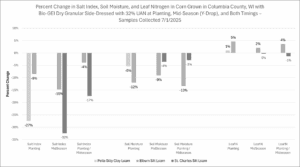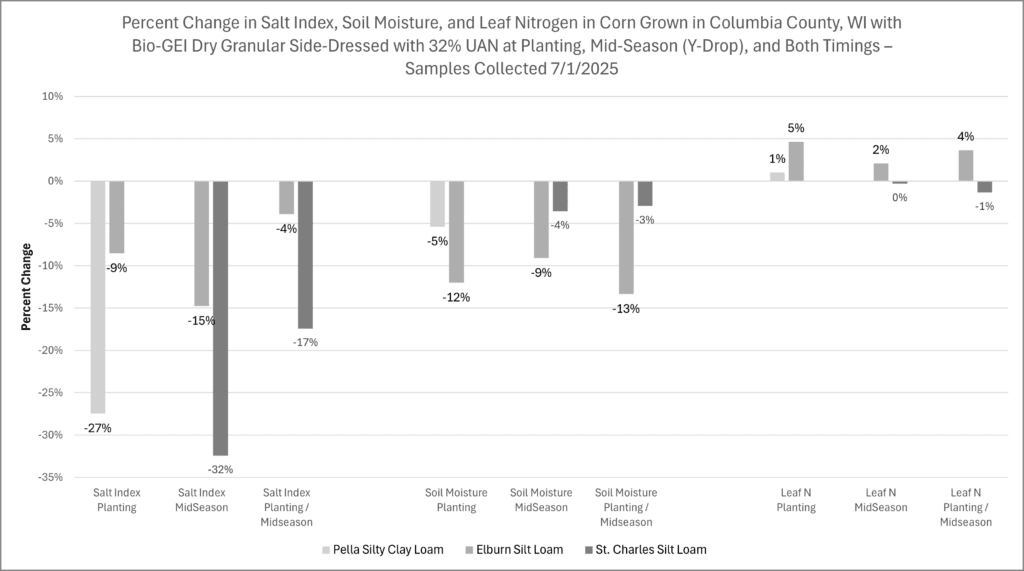Roche Farm Bio-Gel® Dry Granular with UAN On-Farm Trial

Salt Index and Osmotic Pressure Gradients
The Salt Index shows a consistent and significant decrease across all soil types and application timings, with reductions as high as -32% in the St. Charles Silt Loam at mid-season. These reductions are critical, as the salt index is directly tied to the osmotic pressure gradient between the soil and the plant root zone. High salt concentrations typically elevate osmotic pressure, making it more difficult for water and nutrients—especially nitrogen—to move into plant roots.
The substantial decreases in salt index indicate that Bio-Gel is effectively buffering the salts in UAN, thereby reducing osmotic stress and restoring the gradient that favors water and nutrient uptake.
Water Movement and Volumetric Water Content (VWC)
Bio-Gel also reduced VWC in all scenarios, particularly in the Elburn Silt Loam, with a -17% change when both planting and mid-season applications were used. This may initially seem
counterintuitive, but it supports the concept of enhanced water uptake by the plant due to improved osmotic conditions—less salt stress means the plant can more effectively draw in water from the soil.
Nitrogen Assimilation
Most notably, Leaf Nitrogen content increased in all three soils when Bio-Gel was used, with a 5% increase in Elburn Silt Loam at planting and a 4% increase in St. Charles Silt Loam with combined application. These increases directly correlate with improved nitrogen assimilation, made possible by the more favorable osmotic environment created by Bio-GEI’s salt-buffering capacity.
Insights & Implications
These findings strongly support the role of Bio-Gel Dry Granular as a salt-buffering agent, especially when used with salt-heavy fertilizers like UAN. By regulating the osmotic pressure gradient, Bio-Gel facilitates more efficient movement of water and nitrogen into plants, leading to improved nitrogen uptake and plant health. This makes it a valuable tool for managing saline soils and enhancing nutrient efficiency in liquid fertilizer programs.
1. Salt Buffering Technology
· Bio-GEI reduces the salt index of UAN by up to 32%, protecting crops from salt-induced osmotic stress.
· By moderating salt concentration, Bio-Gel allows for safer use of high-salt liquid fertilizers, especially in saline soils.
2. Enhanced Nitrogen Uptake
· Increases leaf nitrogen content by up to 5%, leading to more efficient nitrogen assimilation and potentially higher yield.
· Improved nutrient uptake is observed across multiple soil types, demonstrating wide adaptability.
3. Regulated Osmotic Gradient = Better Water Movement
· Helps maintain optimal osmotic pressure around root zones.
· Promotes water flow into the plant by reducing salt-induced water retention in the soil.
4. Multiple Timing Flexibility
· Works effectively when UAN is applied at planting, mid-season (Y-drop), or in combination—giving growers timing flexibility.
5. Compatibility with High-Salt Inputs
· Ideal for growers using 32% UAN or similar high-salt fertilizers.
· Provides a protective buffer in situations where root burn or salt stress is a concern.
6. ROI Through Efficiency
· Improved nutrient use efficiency (NUE) can reduce total nitrogen application rates without sacrificing crop performance.

